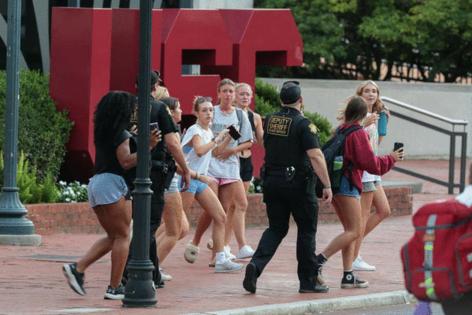'Purgatory' behind active shooter hoax at University of South Carolina, state attorney general says
Published in News & Features
COLUMBIA, S.C. — A recent swatting incident at the University of South Carolina, where reports of an active shooter on campus that turned out to be a hoax, was the work of “an online gore-seeking group,” according to South Carolina Attorney General Alan Wilson.
A group called Purgatory was behind the Aug. 24 phone calls that reported gunfire at Thomas Cooper Library in the heart of USC’s Columbia campus, Wilson said Tuesday in a news release. Although it turned out that there were no shots fired, fear and chaos temporarily gripped the university as the campus was placed on lockdown and students were told to evacuate the area and find shelter.
The active shooter hoax calls were linked to Purgatory by the Center for Internet Security and Institute for Strategic Dialogue, according to the release. While researchers have linked Purgatory to several other universities that received similar hoax calls over that weekend, there is no confirmation yet that Purgatory was the group behind the USC hoax.
“I’ve spoken to USC President Michael Amiridis, and he has my full support to do what is necessary to protect our students and keep our campuses safe,” Wilson said in the release. “I will continue to warn young people and parents about the dangers of these online criminal groups.”
Similarities to other hoax calls
In an interview with Wired.com, referenced by Wilson, a self-proclaimed leader of the group going by the name “Gores” said that they were paid to carry out the calls. The hoax is often called “swatting” and it is intended to provoke a significant response by heavily armed law enforcement.
USC was one of several universities that received false active shooter reports. Similar incidents involved schools including Villanova University, the University of Tennessee at Chattanooga, the University of Arkansas and Iowa State University.
The call reporting a shooter at the Thomas Cooper library had significant similarities to the other hoax calls. Among them were claims that the shooting was taking place in a library. Several of the calls also had sounds of gunfire in the background, which was believed to have been generated by AI.
The connection is “not 100% certain because nobody has been arrested or charged,” said Robert Kittle, communications director at the Attorney General’s Office.
The investigation into the incident by university police and the South Carolina Law Enforcement Division is still ongoing, USC spokesman Jeff Stensland said.
“Our campus community and first responders from multiple partner agencies did an exceptional job responding to the incident on Aug. 24,” Stensland said in a statement. “Swatting is not a harmless prank, and we thank the Attorney General for helping to inform the public about these groups that seek to inflict pain and create fear.”
A spokesperson for SLED said that the agency was looking into the statement from the attorney general’s office.
In response to an inquiry from The State, a spokesperson for the FBI’s Columbia field office said that he could not confirm whether the agency has an open investigation but did state that the federal agency would have jurisdiction into the crime because it involved the use of cellphones and the internet.
Was hoax shooting linked to violent online community?
Wilson linked Purgatory to 764, a violent online subculture that promotes violence, child sex abuse and self-harm. The goal is often to produce pictures or videos of these criminal acts that are then shared among members of these groups, according to extremism researchers.
“The 764 network is a growing threat,” said Kevin Wheeler, a spokesperson for the FBI’s Columbia office.
Wilson said Purgatory and similar online criminal groups “direct, produce, and distribute child sexual abuse material (child pornography), often grooming and manipulating minors into producing the material or encouraging them to harm themselves through cutting themselves or creating and sharing violent or bloody videos or photos.”
Those perpetuating these trends, who Wilson said are often teens themselves, seek to generate online gore material through coercion and victimization of other teens, including but not limited to: cutting, blood signs, child sexual abuse material, sextortion, bestiality, the torture or killing of animals, and documented suicide.
These subjects also encourage their victims to become the subject and victimize others via online video games and chat rooms, according to the release.
Leaders of these online trends also often encourage and execute attacks on others via swatting and bomb threats, similar to what happened on the USC campus, according to Wilson.
On Aug. 24, USC’s dispatch line received two separate calls, with what sounded like gunfire in the background, Stensland told The State. One around 6:30 p.m., the next around 6:32 p.m. This prompted the safety alert.
But USC officials said around 7:15 p.m. on Sunday there was “no evidence” of an active shooter, and at 8:05 p.m., the university issued an “all clear.”
“We could not find an active shooter. We did find people who said they heard something that could have been gunshots. We didn’t find any shell casings,” Scott Prill, the university’s deputy police chief, said at a news briefing Sunday evening. “We also received some reports that there have been some other hoaxes at universities.”
_____
©2025 The State. Visit thestate.com. Distributed by Tribune Content Agency, LLC.







Comments